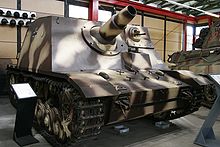
An assault gun is a type of armored infantry support vehicle and self-propelled artillery, mounting an infantry support gun on a protected self-propelled chassis, intended for providing infantry with heavy direct fire support during engagement, especially against other infantry or fortified positions, secondarily also giving some armored protection and anti-armor capability.

The Panzerkampfwagen III , commonly known as the Panzer III, was a medium tank developed in the 1930s by Germany, and was used extensively in World War II. The official German ordnance designation was Sd.Kfz. 141. It was intended to fight other armoured fighting vehicles and serve alongside and support the similar Panzer IV, which was originally designed for infantry support.

The Panzerkampfwagen IV, commonly known as the Panzer IV, is a German medium tank developed in the late 1930s and used extensively during the Second World War. Its ordnance inventory designation was Sd.Kfz. 161.

This article lists production figures for German armored fighting vehicles during the World War II era. Vehicles include tanks, self-propelled artillery, assault guns and tank destroyers.
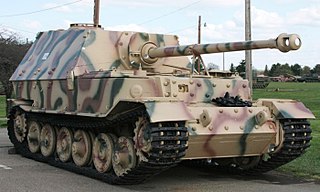
Elefant was a heavy tank destroyer used by German Panzerjäger during World War II. Ninety-one units were built in 1943 under the name Ferdinand using VK 45.01 (P) tank hulls which had been produced for the Tiger I tank before the competing Henschel design had been selected.

Sturmtiger was a World War II German assault gun built on the Tiger I chassis and armed with a 380mm rocket-propelled mortar. The official German designation was Sturmmörserwagen 606/4 mit 38 cm RW 61. Its primary task was to provide heavy fire support for infantry units fighting in urban areas. The few vehicles produced fought in the Warsaw Uprising, the Battle of the Bulge and the Battle of the Reichswald. The fighting vehicle was known by various informal names, among which the Sturmtiger became the most popular.

The Sturmgeschütz III was an assault gun produced by Germany during World War II. It was the most-produced fully tracked armoured fighting vehicle, and second-most produced German armored combat vehicle of any type after the Sd.Kfz. 251 half-track. It was built on a slightly modified Panzer III chassis, replacing the turret with an armored, fixed superstructure mounting a more powerful gun. Initially intended as a mobile assault gun for direct-fire support for infantry, the StuG III was continually modified, and much like the later Jagdpanzer vehicles, was employed as a tank destroyer.

Nashorn, initially known as Hornisse, was a German Panzerjäger of World War II. It was developed as an interim solution in 1942 by equipping a light turretless chassis based on the Panzer III and Panzer IV tanks with the 8.8 cm Pak 43 anti-tank gun. Though only lightly armoured and displaying a high profile, it could penetrate the front armour of any Allied tank at long range, and its relatively low cost and superior mobility to heavier vehicles ensured it remained in production until the war's end.

Panzerjäger is a term used for an anti-tank vehicle, as well as anti-tank units. The term was first used in the Wehrmacht, and also post-war by the German Federal Republic Bundeswehr. The term Panzerjäger was used in the Bundeswehr as a designation of rank.
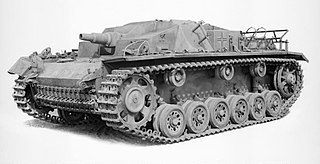
Sturmgeschütz meaning "assault gun" was a series of armored fighting vehicles used by both the German Wehrmacht and the Waffen-SS formations during the Second World War (1939–1945). The main StuGs were the StuG III and StuG IV based on the Panzer III and Panzer IV medium tank chassis respectively.

The Sturmgeschütz IV was a German assault gun variant of the Panzer IV used in the latter part of the Second World War. It was identical in role and concept to the highly successful StuG III assault gun variant of the Panzer III. Both StuG models were given an exclusively tank destroyer role in German formations and tactical planning in the last two years of the war, greatly augmenting the capability of the dwindling tank force available to the German army on the Eastern and Western fronts.

The Jagdpanzer IV / Sd.Kfz. 162, was a German tank destroyer based on the Panzer IV chassis and built in three main variants. As one of the casemate-style turretless Jagdpanzer designs, it was developed against the wishes of Heinz Guderian, the inspector general of the Panzertruppen, as a replacement for the Sturmgeschütz III. Guderian objected against the needless diversion of resources from Panzer IV tank production, as the StuG III was still more than adequate for its role.

The 15 cm sIG 33 (Sf) auf Panzerkampfwagen 38(t), also known as Grille was a series of self-propelled artillery vehicles used by Nazi Germany during World War II. The Grille series was based on the Czech Panzer 38(t) tank chassis and used a 15 cm sIG 33 infantry gun.
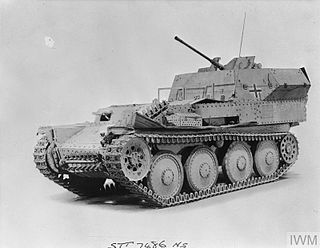
The Flakpanzer 38(t), officially named Flakpanzer 38(t) auf Selbstfahrlafette 38(t) Ausf M , was a German self-propelled anti-aircraft gun used in World War II. It is sometimes incorrectly referred to as the Gepard, which may lead to confusion with the unrelated Flakpanzer Gepard.
The Panzerkampfwagen I was a light tank produced in Germany in the 1930s. The Panzer I was built in several variants and was the basis for a number of variants listed below.
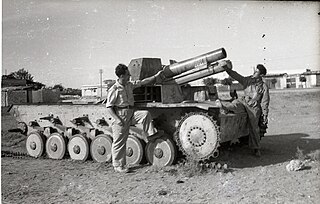
The 15 cm sIG 33 auf Fahrgestell Panzerkampfwagen II (Sf), sometimes referred to as the Sturmpanzer II Bison, was a German assault gun used during World War II. The dozen vehicles produced were assigned to the 90th Light Infantry Division in North Africa during the war.

The 15 cm sIG 33 (Sf) auf Panzerkampfwagen I Ausf B, sometimes referred to (unofficially) as the Sturmpanzer I Bison, was a German self-propelled gun used during World War II.
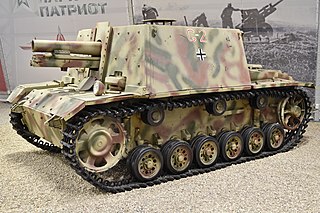
The Sturm-Infanteriegeschütz 33B, was a German self-propelled heavy assault gun used during World War II.



